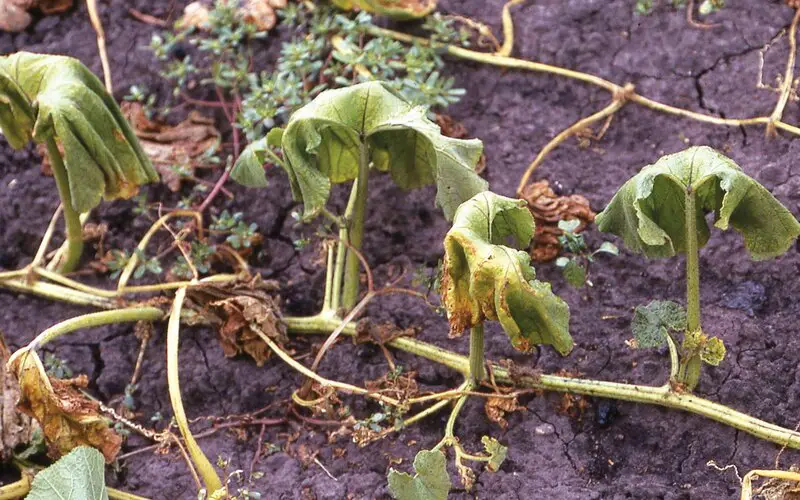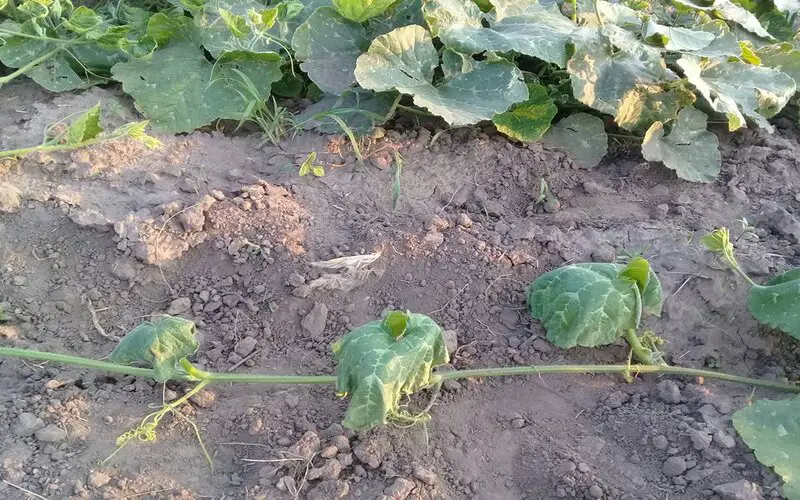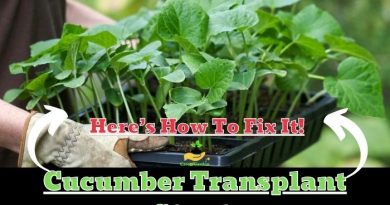Why is My Cucumber Plant Wilting? Here’s How To Stop It!
Are you frustrated with your cucumber plant wilting? Don’t let your gardening efforts go to waste! If a cucumber plant starts wilting, it is definitely not properly cared for.
Knowing the causes of cucumber plant wilting and how to avoid it is, therefore, vital. As a result, in this article, I have gathered all the suitable and helpful information regarding cucumber withering. To learn more, keep reading.
Your cucumber plants are wilting due to a lack of water, poor soil conditions, pest infestations, disease, or environmental factors such as heat or cold. To diagnose and treat cucumber plant wilting, observe the plant’s symptoms, check the soil moisture, and consider environmental factors. Proper watering, soil maintenance, and pest control can prevent cucumber plant wilting in the future.
Common Causes of Cucumber Plant Wilting
1. Bacterial Wilt

Bacterial wilt is the main cause of cucumbers wilting and dying. This is an infection that spreads through the entire plant, clogging the leaves and stems with a slimy, sticky substance that prevents water and nutrients from traveling through the plant.
The easiest way to tell if a cucumber plant has bacterial wilt is to cut a stem and place a finger over the cut end. If a sticky substance comes out of the cut end and sticks to your finger, the plant is suffering from the disease.
Symptoms of Bacterial Wilt
| Symptom on Cucumbers | Description |
|---|---|
| Leaves Droop During the Day | Leaves exhibit drooping or wilting during the day. |
| Foliage Regenerates at Night | The foliage shows signs of recovery or regeneration during the night. |
| Stems and Shoots Wither | Stems and shoots of the plant begin to wither and weaken. |
| Limp Foliage | Foliage remains limp and does not recover in the late stage. |
The fact that cucumber plants wilt even after receiving enough water is one indication of bacterial wilt. Cut a severely wilted stem just above the soil and squeeze it to test the cucumbers. Bacterial wilt manifests as a sticky, oozy material.
The plant can’t take in the water it requires because this sticky material clogs its circulatory system. Cucumbers and muskmelons suffer cucumber wilt damage quickly. After a week, you could start to see dull areas on the leaves.
The entire vine will begin to wilt after two weeks, and the fruits will seem malformed and undersized. There is frequently no leaf yellowing.
The leaves of the affected cucumber plant will first wilt during the day. However, during the cool night, the cucumber recovers. Later, the leaves remain wilted throughout the day and eventually die.
Depending on the causative fungus, differently colored coatings form on the stems and leaves. The flowers fall off, and young cucumbers remain small and wither on the plant until they fall off. The shoots rot and wither until the cucumber finally dies off completely.
Causes
Cucumber beetles are responsible for spreading bacterial wilt. When they feed on an infected plant, the bacteria remain in their bodies, even for a whole winter. When infected beetles feed on a healthy plant with a deep cut or wound, the bacteria enter the plant and infect it.
Because the beetles feed on cucumbers that are already wilted, most of them carry the bacteria and spread it from plant to plant.
In the cucumber beetle’s digestive tract, the bacteria overwinter. The striped and spotted cucumber beetles, which feed on cucumbers and other members of this family, transfer bacterial wilt from plant to plant in the spring.
The bacteria enter host plants through stomates and wounds, most likely those caused when the insects eat, and are then discharged through the insect feces. As they consume bacteria-infected plants, insects swallow more, and the cycle is repeated.
Treatment
There is no treatment for cucumber vines infected with bacterial wilt. Dig up and discard the affected vines.
This helps prevent the spread of disease among cucumber vines and other garden plants, such as pumpkin, cantaloupe, and squash. Infected vines left behind also attract other pests that damage other garden plants.
To prevent the fungi spores from spreading further in the environment, you must dispose of the affected cucumber plant in an airtight package, which I recommend you throw in household waste.
If the cucumber was cultivated in the greenhouse, it should be carefully chopped up in the greenhouse and packed in a bag. As a result, the plants in the vicinity of the infested plant should be observed closely and removed and destroyed if there are signs of cucumber wilt.
Table bacterial wilt resistant cucumbers
| Cucumber Variety | Resistance to Bacterial Wilt |
|---|---|
| ‘Marketmore 76’ | Highly resistant |
| ‘Dasher II’ | Highly resistant |
| ‘Sweet Success’ | Highly resistant |
| ‘Salad Bush’ | Highly resistant |
| ‘Tasty Green’ | Highly resistant |
| ‘Socrates’ | Moderately resistant |
| ‘Picolino’ | Moderately resistant |
| ‘General Lee’ | Moderately resistant |
| ‘Armenian Yard Long’ | Moderately resistant |
| ‘Divinity’ | Moderately resistant |
| ‘Corinto’ | Moderately resistant |
Prevention of Bacterial Wilt
Healthy, strong cucumber plants are not attacked by cucumber wilt as quickly as weak and diseased plants.
Eliminating cucumber beetles is the best way to prevent bacterial wilt. Remove all remaining vegetation in the fall so the beetles have no place to hide during the winter. Spring tillage kills the eggs.
Covering emerging cucumber plants with cheesecloth or floating blankets in rows keeps the beetles out.
Insecticides containing pyrethrum kill the adults, reducing the population and the risk of spreading the bacteria.
Therefore, good care for the cucumbers is particularly important. In addition to enough water and fertilizer, there are a few other things that are important.
This includes finding a good location for the plants. It should be airy, but without drafts. In addition, the climate should be as balanced as possible. Greater temperature differences can also weaken cucumbers.
Once the cucumber wilt has occurred, no more cucumbers should be brought to the affected area for the time being. In the greenhouse or cold frame, it is a good idea to replace the soil and either dispose of it in the household waste or sterilize it in the oven.
2. Low Temperatures
Given that cucumbers dislike the cold, it may not come as a surprise that lower temperatures can make them wilt. Cucumbers like all plants may have a harder time absorbing water in cold weather, especially if the ground is frozen.
Furthermore, fungi thrive in cold, moist soil, and some of them might harm your cucumber plants. When the temperature falls below 50 degrees Fahrenheit and the soil surrounding your cucumber plants is wet, look for evidence of fungal development around the roots of the plants.
Treatment
Although you can’t change the weather, you can lessen its consequences. Mulch the area surrounding your cucumber plants if a cool front is on its way.
This keeps the roots warm and prevents the soil’s water from freezing by insulating the soil. Before any chilly weather or freezing rain arrives, cover your cucumbers to protect the leaves from the cold.
Watering your cucumbers with room-temperature water rather than cold water might help reduce the chill if the weather is chilly but not freezing.
But so that the cucumbers do not bend from the cold, it is better, of course, to immediately grow them in a warm garden. But if your bed is the most common, you will have to turn up the heat.
For this, stones or plastic water bottles will fit; they will be the so-called heat accumulators. Lay them out in your garden to keep them warm throughout the day. And in the evening and at night, according to the laws of physics, they will begin to give off this very warmth.
3. Lack of Water

Lack of water is a significant cause of cucumber leaf wilting or withering. When cucumber plants do not receive an adequate water supply, they experience water stress, which can lead to various physiological changes and impact their overall health.
As a rule, when there is not enough moisture for cucumbers, the top of the bush begins to wither, and the rest of the leaves keep doing well.
Here’s a breakdown of how the lack of water leads to wilting in cucumber plants:
| Lack of water effects on cucumber | Description |
|---|---|
| Water Uptake | Inadequate water availability in the soil hinders the cucumber plant’s ability to absorb water effectively through its roots. |
| Transpiration | Water scarcity leads to a reduction in transpiration, the process by which plants lose water through stomata, to conserve water. |
| Reduced Turgor Pressure | Insufficient water causes a decrease in turgor pressure within plant cells, resulting in flaccidity and wilting of leaves and stems. |
| Disrupted Water Transport | Water deficiency disrupts the movement of water and nutrients through the plant’s vascular system, further contributing to leaf wilting. |
| Stomatal Closure | To conserve water, the plant partially closes its stomata, which limits the intake of carbon dioxide for photosynthesis and leads to wilting. |
| Energy Production Reduction | Decreased water availability impairs the plant’s ability to produce energy through photosynthesis, affecting overall growth and vigor. |
| Progression to Leaf Withering | If water deficiency persists, wilting can progress to leaf withering and ultimately plant decline as essential functions are compromised. |
Treatment
Cucumbers consist mostly of water and the need is correspondingly high. The soil should be kept regularly moist and watered at least daily on hot and dry days.
Optimally, every other day in the heat, every day in the evening. If the soil does not have time to dry out, this will result in fungal infections, and then the problem is gone.
The cucumbers are watered in the morning, since evaporation is at its lowest at this time. In the evening, however, the soil is too warm. The daily water requirement of a single plant is around 1.5 to 3 liters per day.
But not only the amount makes the difference: if you water your cucumbers incorrectly, you can soon expect fungal diseases. These dry up the leaves of the cucumbers and also damage other plants in the area.
To prevent fungus formation, always keep water close to the ground. Watering the leaves encourages infestation.
3.1 Watering with cold water
If you water the cucumber plant with water that is too cold, the water absorption capacity of the roots decreases significantly. The plant goes into a cold shock state. As a result, wilting of the leaves and the death of cucumbers may occur. Cold well or stream water is temporarily stored in a barrel.
This allows the water to adapt to the ambient temperature. It becomes particularly critical on dry summer days: the plants have a very high water requirement, and you water them a lot.
However, the absorption capacity of the cucumber plant is weakened by the amount of cold water. As a result, a lot of water evaporates without having a positive impact on growth.
4. Cucumber Plants Wilting Due to Lack of Hardening Off
Some gardeners start cucumber seeds inside, as was previously described. In chilly locations where late spring frosts can harm cucumber plants, this extends your growth season.
Cucumber plants are exposed to “the elements” for the first time when they are moved outside (wind, rain, heat, cold, insects, etc.). Your seedlings spent their time indoors in a controlled environment prior to transplant.
They are now exposed to a range of daytime wind, water, temperature, and sunshine conditions. For immature cucumber plants, the outdoors may be brutal! It is good to provide seedlings with a gradual transition to the outside environment because of this.
The goal of “hardening off” is to help plants acclimate to life outside in order to prevent transplant shock.
Treatment
Cucumbers can be hardened off by being placed in a greenhouse or cold frame. They can progressively acclimate to increased exposure to the outdoors in this way.
Your cucumber will stay warmer in a greenhouse or cold frame while the evenings are still chilly in the beginning of the growing season.
Another choice for shielding cucumber plants from wind and cold is to use a cloche. Before a hot, sunny day, take off the cloche to avoid overheating your plants.
5. Cucumber Plants Wilting Due to Drought and Heat

Despite the fact that cucumbers like warm climates, they may nevertheless become too hot. During a heat wave, if you see your cucumbers drooping, they can be too hot. After you water them and at night when the temps drop, you’ll probably see an improvement.
If it is too hot, the cucumber plant will wither; if it is too cold, it will slow down in development, stop bearing fruit, and die.
| Cucumber Heat Requirement | Description |
|---|---|
| Temperature Range | Cucumbers thrive in warm temperatures. The ideal temperature range for cucumber growth is typically between 75°F to 85°F (24°C to 29°C). |
| Minimum Temperature | Cucumber plants require a minimum temperature of around 60°F (15°C) for optimal growth. Temperatures below this can inhibit growth and lead to wilting. |
| Maximum Temperature | While cucumbers enjoy warmth, excessive heat can also cause stress and wilting. High temperatures above 90°F (32°C) can negatively impact cucumber plants. |
Treatment
If you can, provide shade for your cucumbers during the warmest time of the day. The alternative remedy for this kind of withering is to give your cucumbers more frequent waterings.
In hot, dazzling conditions, water evaporates more rapidly, giving your cucumber plants less time to absorb the water they require.
5.1 Direct sunlight
On a hot, sunny day, the leaves may begin to wither due to excessively high temperatures and direct sunlight. In order to save the plants, it is necessary to water them abundantly and protect them from the sun’s rays with the help of pieces of cardboard, unnecessary sheets, bags, etc.
Cucumber, of course, is a heat-loving plant, but direct sunlight only harms it; the leaves curl into tubes or wither from them. This issue is solved as easily as shelling pears: it is enough to water the cucumbers and shade them with any materials at hand.
6. Other Diseases
Wilting leaves can be caused by a number of diseases, most of which are deadly. Wilting and light brown streaks on the inside of the leaves and stems are symptoms of verticillium wilt. By growing disease-resistant crop kinds and rotating your crops, you may avoid it.
Both decaying roots and drooping leaves are symptoms of sudden wilt. It is especially common in dense, muddy soils. Plant cucumbers on raised beds or add compost to the drainage system to avoid it.
Fusarium wilt causes cucumber leaves to wilt
Fusarium wilt can also survive in the soil for up to 5 years. The fungus penetrates the cucumber plant via the roots and blocks the water supply. The cucumber leaves are beginning to wilt.
The symptoms include, for example, a white or pink fungus that first spreads on the roots. This can also be observed in the cucumber up to the base of the stalk. The cucumber plant will turn yellow over time and die.
Phytophthora Blight or Crown Rot
A fungus is responsible for Phytophthora blight. An infected cucumber will have dark, wet areas on its leaves, fruit, or stems, and it may also exhibit evidence of white mold development.
It will therefore appear as though the plant is decaying, which is actually what is happening. The cucumber plant is being devoured by a fungus, and as a result, it will eventually wilt, die, and degrade.
Cornell claims that fungicides like Ridomil Gold SL may be sprayed on cucumber plants to prevent phytophthora blight, but it might be difficult to salvage a plant that has already begun to exhibit symptoms.
7. Pests
The majority of insects that attack cucumbers leave behind chewed-up leaves as obvious damage. However, a few might result in withering. For instance, squash bugs burrow through the vines, making the leaves droop.
Treatment
To capture and kill the adult squash bugs, lay down boards in the garden. Find any tiny eggs at the plant’s base and kill them. The fluids are sucked out of the leaves and stems by aphids, which results in stippling, curled, or wilted leaves.
Along with black soot, a fungus that consumes honeydew, you could also see honeydew, a sticky material secreted by the bugs, on the leaves and the ground.
Spray a constant stream of water on the tops and undersides of the leaves to get rid of aphids. Spraying the foliage with insecticidal soap is an additional alternative. Add 1 gallon of water to 2.5 ounces of concentrate. On a cold, overcast day, apply the substance and fully cover the foliage.
8. Overcrowding
Naturally, no plant will like it if its neighbors grow too close to it. Cucumbers are no exception. As soon as they begin to grow, the soil bed will turn into a chaotic ball of stems and leaves.
It is not surprising that in such a mess, some plants like cucumbers will not have enough light and nutrients, resulting in leaves beginning to turn yellow and wither.
Treatment
The only way out of this situation is thinning: remove excess leaves and shoots, pinch growth points, remove weak shoots and bad leaves so that they do not take away nutrients and do not create an extra shadow; the strongest survive.
It is also recommended to remove weakened whips and leaf plates that are already old and turning yellow.
9. Herbicide Exposure
Cucumbers do not like chemicals. They are sensitive to herbicides, even if you treat neighboring soil beds with chemicals. Because of this, cucumber leaves can wither in a matter of days. So the only way out of this situation is to keep herbicides away from cucumbers.
How to Prevent Cucumber Plant Wilting
If you notice that your cucumber plant is deteriorating, you must first identify the root of the problem. This stage is extremely important because, without knowing the cause of your plant’s death, you cannot remedy it.
Look for bugs or insects on your cucumber’s leaves and the surrounding soil. Verify whether the plant is receiving the necessary quantity of sunshine.
There are a few things you may do to revive your plant once you have identified the specific reason for its death. Use insecticides to keep pests away from your crop if they are seen above the plant or close by.
Verify that your plant is not surrounded by weeds. Keep your crop’s surroundings tidy and remove any yard waste.
Make a good watering schedule and follow it if inconsistent watering is the cause of your plant’s demise.
Avoid overwatering your cucumber plant. Additionally, early morning watering is better for the plants, at least in my own experience.
Place the plant in a location in your home that receives the most sunshine. The cucumber plant has to be trellised as the final step.
Trellising will keep the crop up and off the ground, decreasing the likelihood of insect assaults and enhancing air flow.
How do you revive a wilted cucumber plant?
To revive a wilted cucumber plant, you can follow these steps:
- Water the Plant: The first and most crucial step is to provide the plant with adequate water. Give the plant a deep watering, ensuring the soil is thoroughly moistened. Water slowly and deeply at the base of the plant to encourage the roots to absorb water effectively.
- Shade and Reduce Heat Stress: If the wilting is due to heat stress, provide temporary shade to protect the plant from direct sunlight during the hottest part of the day. Use shade cloths, umbrellas, or any other suitable materials to shield the plant from excessive heat. This will help reduce water loss through transpiration and allow the plant to recover.
- Prune Damaged Leaves: Trim off any severely wilted or damaged leaves from the plant. This will help the plant redirect its energy towards new growth and prevent further water loss through the damaged foliage.
- Mulch the Soil: Apply a layer of organic mulch, such as straw or wood chips, around the base of the cucumber plant. Mulching helps retain soil moisture, regulate soil temperature, and reduce water evaporation from the soil surface. It also provides a barrier against weed growth that can compete for water and nutrients.
- Ensure Proper Drainage: Make sure the soil has good drainage to prevent waterlogging, which can suffocate the roots and further damage the plant. If the soil is compacted or retains excessive water, consider improving the drainage by adding organic matter or creating raised beds.
Should I remove wilted cucumber leaves?
It is good to remove the withered leaves or those that do not even seem to be in good condition from the plant. By removing wilted leaves, cucumbers can redirect their resources, such as water and nutrients, towards healthier parts of the plant. This allows the plant to focus its energy on new growth and recovery.
When the leaves have fully developed, cut away the wilted and dry parts of the cucumber plant. If you don’t see any improvement in this time frame, double check the stems and prune away dead branches and dead leaves. You will see that in less than three weeks, the first gherkins will begin to appear.
Why are my cucumbers wilting after transplant?
After transplanting cucumber plants, wilting can occur due to a phenomenon known as transplant shock. This happens because cucumbers experience stress during the transplanting process, causing their roots to temporarily struggle with water absorption. Additionally, inadequate watering or overwatering after transplanting can contribute to wilting.
Plants with large leaves (such as cucumbers, chard, and squash) may wilt in the late afternoon on very hot days, even when the soil is relatively moist; this is generally because water loss from the leaves exceeds water replenishment through the roots.
Conclusion
Now that you know what to look for, you can figure out why your cucumber plants are withering. The problem is probably a lack of water, or the weather is very hot or cold. If not, it may be bacterial wilt, which is brought on by cucumber bugs.
The remedy might be as easy as adding some mulch or giving them more water, or it could be as difficult as removing the affected plant and altering your planting date, depending on the reason. I wish you success as you safeguard and tend to your cucumber plants!
I hope the advice I provided in this post will help you resurrect your cucumber plant.




